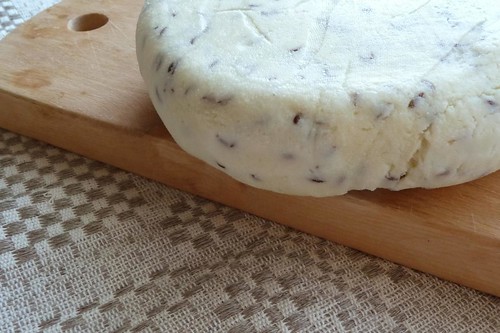 |
Traditional Latvian dress worn for
festivals and special occasions
displayed at the Oregon Latvian
Center, 5500 SW Dosch Road,
Portland, Oregon.
|
To help Gunta feel more at home here in the states, my brother found a website for a Latvian Center in Portland, Oregon and soon they were shuttling back and forth between Pendleton, where they lived, to various activities at the Latvian Center. Then this year, my brother and Gunta moved to the Portland area so they could be closer to other members of the Portland Latvian community. When I was visiting them in their new home in Columbia City, Gunta mentioned they were eagerly anticipating the annual holiday bazaar that would be held on Thanksgiving weekend at the Latvian Center and I asked if I could go with them.
 |
Carraway-flavored Jānu siers, a fresh-cooked cheese, is a
traditional food prepared for the festival of Jāni celebrating
the summer solstice. Photo courtesy of The Kitchen Mouse.
|
I bought a handmade knitted doll in a traditional Latvian costume, some fragrant soap with a picture of two women in Latvian dress on it and a braided loaf of sweet saffron bread with almonds and raisins called Klingeris that I will freeze then warm up for our family Christmas celebration.
At noon, lunch was announced and I indulged myself with some of the most delicious cabbage rolls I had ever eaten along with mashed potatoes and a specially seasoned gravy, salad and buttered peas served with Saldskabmaize, a sweet and sour rye bread. Unlike the cabbage rolls I had eaten at a little Russian café in west Eugene that were simmered in a tomato sauce, these were simmered in the broth from the seasoned ground beef filling similar to these Polish golabki .
 |
| Polish cabbage rolls known as golabki. Photo courtesy of About East European Food. |
Afterwards, Gunta and I shared a piece of hazelnut torte frosted with delicately sweetened whipped cream and finely ground hazelnuts. I found a recipe on the web for Latvian Hazelnut Torte but noticed it was frosted with a mocha buttercream frosting. I'm sure I prefer the sweetened whipped cream as it is much less sugary and lets you enjoy the delicate flavor of the nuts. Gunta told me that many desserts in Latvia are garnished with sweetened whipped cream rather than the heavier sugar-based frostings used so often here in the states.
I also learned that hazelnuts grow wild in Latvia so hazelnut torte has been a festival dessert there for centuries. Hazelnuts grow wild here in Oregon too but a more robust variety was commercially planted at Dorris Ranch here in Springfield in 1903. That orchard was the foundation for today's thriving Oregon hazelnut industry.
Cake-like desserts made from ground nuts or nut flour have been documented as far back as the 17th century. The Linzer torte, based on a recipe dating back to 1696 (or possibly an earlier recipe found in a 1653 codex), was originally made from almonds but almonds were so expensive that only wealthy nobles could afford dishes prepared with them. So the dessert was modified to use walnuts or hazelnuts that were more readily available.
Needless to say I enjoyed every bite of the delicious Latvian cuisine. I look forward to going to Latvia with Joe Bill and Gunta one day. They still maintain a flat in Riga and visit Latvia every couple of years so hopefully I won't have to wait too long!

No comments:
Post a Comment